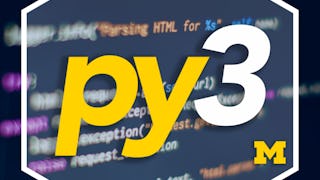Filter by
SubjectRequired
LanguageRequired
The language used throughout the course, in both instruction and assessments.
Learning ProductRequired
LevelRequired
DurationRequired
SkillsRequired
SubtitlesRequired
EducatorRequired
Explore the UML Diagram Course Catalog
 Status: Free Trial
Status: Free TrialUniversity of Michigan
Skills you'll gain: Application Deployment, Django (Web Framework), Object-Relational Mapping, HTML and CSS, Model View Controller, jQuery, Ajax, JSON, Database Design, SQL, Application Frameworks, Databases, Application Development, Javascript, Object Oriented Programming (OOP), Web Development, Data Modeling, Application Security, Web Applications, Web Servers
 Status: Free Trial
Status: Free TrialUniversity of Minnesota
Skills you'll gain: Enterprise Resource Planning, Business Systems Analysis, Systems Analysis, Requirements Analysis, Cybersecurity, Business Requirements, Business Systems, Cloud Computing, Cloud Services, IT Management, Change Management, Information Technology, Organizational Change, Technology Strategies, Process Flow Diagrams, System Implementation, User Requirements Documents, Data Modeling, Enterprise Architecture, Portfolio Management
 Status: NewStatus: Free Trial
Status: NewStatus: Free TrialSkills you'll gain: ASP.NET, Database Development, C# (Programming Language), Back-End Web Development, Database Management, Database Design, Object-Relational Mapping, Application Frameworks, Model View Controller, Web Applications, Software Design Patterns, Authentications, Maintainability, Business Logic, Authorization (Computing), Data Modeling, Performance Tuning, Data Migration, Data Mapping, Data Validation
 Status: Free Trial
Status: Free TrialUniversity of Michigan
Skills you'll gain: Unified Modeling Language, JSON, Object Oriented Programming (OOP), Software Design, Debugging, Object Oriented Design, Data Processing, Web Scraping, Unit Testing, Programming Principles, Data Import/Export, Restful API, Python Programming, Image Analysis, Data Manipulation, Jupyter, Maintainability, Data Structures, Software Engineering, File Management
 Status: NewStatus: Free Trial
Status: NewStatus: Free TrialSkillUp EdTech
Skills you'll gain: Data Migration, Data Architecture, Data Governance, Extract, Transform, Load, Data Integration, Database Design, Enterprise Architecture, Database Architecture and Administration, Data Modeling, Data Strategy, Data Management, Solution Architecture, Data Infrastructure, Data Pipelines, Data Warehousing, Data Security, Data Integrity, Data Storage, Data Quality, Scalability
 Status: Free Trial
Status: Free TrialSkills you'll gain: Marketing Analytics, Bayesian Statistics, Descriptive Statistics, Marketing Effectiveness, Statistical Hypothesis Testing, A/B Testing, Target Audience, Marketing Strategies, Marketing Planning, Statistical Inference, Sampling (Statistics), Data Collection, Data Modeling, Statistics, Advertising Campaigns, Campaign Management, Marketing, Analytics, Google Analytics, Data Analysis

University of Michigan
Skills you'll gain: 3D Modeling, Design Elements And Principles, Visualization (Computer Graphics), Computer-Aided Design, Design, Mechanical Design, Architectural Design, Virtual Environment, Creativity
 Status: NewStatus: Free Trial
Status: NewStatus: Free TrialSkills you'll gain: Business Process Modeling, Performance Measurement, Process Analysis, Process Mapping, Gap Analysis, Business Process Improvement, SAP Applications, Dashboard, Data Visualization, Root Cause Analysis, Data-Driven Decision-Making, ChatGPT
 Status: New
Status: NewSkills you'll gain: Figma (Design Software), Software Design Documents, Technical Documentation, User Interface and User Experience (UI/UX) Design, Software Design, Prototyping, Technical Communication, Style Guides, UI Components
 Status: Free Trial
Status: Free TrialColumbia University
Skills you'll gain: Project Schedules, Project Risk Management, Scheduling, Construction Management, Timelines, Lean Methodologies, Construction, Project Management Software, Work Breakdown Structure, Resource Allocation, Probability & Statistics
 Status: Free Trial
Status: Free TrialSkills you'll gain: Stakeholder Engagement, Business Intelligence, Data Integration, Dashboard, Business Analytics, Real Time Data, Data Modeling, Data-Driven Decision-Making, Data Analysis, Requirements Elicitation, Business Metrics, Key Performance Indicators (KPIs), Data Pipelines, Project Documentation
 Status: NewStatus: Free Trial
Status: NewStatus: Free TrialUniversity of Virginia
Skills you'll gain: Model View Controller, Debugging, JSON, Version Control, Responsive Web Design, Data Modeling, User Interface (UI), HTML and CSS, OpenAI, User Story, NoSQL, Test Case, ChatGPT, Application Deployment, Software Development Tools, Algorithms, Generative AI, Web Design and Development, Google Cloud Platform, User Interface and User Experience (UI/UX) Design
UML Diagram learners also search
In summary, here are 10 of our most popular uml diagram courses
- Django for Everybody: University of Michigan
- Information Systems: University of Minnesota
- Database Management and Core Application Development: Packt
- Python 3 Programming: University of Michigan
- Data Architect Capstone Project: SkillUp EdTech
- Meta Marketing Science Certification Prep: Meta
- Introduction to 3D Modeling: University of Michigan
- Business Process Modeling and Analysis: SAP
- Handshake Ready: Design Specs & Handoff in Figma: Coursera
- Construction Scheduling: Columbia University










